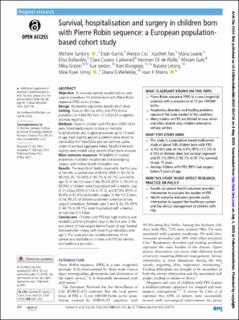| dc.contributor.author | Santoro, Michele | |
| dc.contributor.author | Garne, Ester | |
| dc.contributor.author | Coi, Alessio | |
| dc.contributor.author | Tan, Joachim | |
| dc.contributor.author | Loane, Maria | |
| dc.contributor.author | Ballardini, Elisa | |
| dc.contributor.author | Cavero-Carbonell, Clara | |
| dc.contributor.author | de Walle, Hermien E.K. | |
| dc.contributor.author | Gatt, Miriam | |
| dc.contributor.author | Gissler, Mika | |
| dc.contributor.author | Jordan, Sue | |
| dc.contributor.author | Klungsøyr, Kari | |
| dc.contributor.author | Lelong, Natalie | |
| dc.contributor.author | Urhoj, Stine Kjaer | |
| dc.contributor.author | Wellesley, Diana G. | |
| dc.contributor.author | Morris, Joan K. | |
| dc.date.accessioned | 2023-07-07T08:21:34Z | |
| dc.date.available | 2023-07-07T08:21:34Z | |
| dc.date.created | 2023-07-04T13:54:42Z | |
| dc.date.issued | 2023 | |
| dc.identifier.issn | 0003-9888 | |
| dc.identifier.uri | https://hdl.handle.net/11250/3077043 | |
| dc.description.abstract | Objective: To evaluate survival, hospitalisations and surgical procedures for children born with Pierre Robin sequence (PRS) across Europe.
Design: Multicentre population-based cohort study.
Setting: Data on 463 live births with PRS from a population of 4 984 793 from 12 EUROCAT congenital anomaly registries.
Methods: Data on children with PRS born 1995–2014 were linked electronically to data on mortality, hospitalisations and surgical procedures up to 10 years of age. Each registry applied a common data model to standardise the linked data and ran common syntax scripts to produce aggregate tables. Results from each registry were pooled using random-effect meta-analyses.
Main outcome measures: Probability of survival, proportion of children hospitalised and undergoing surgery, and median length of hospital stay.
Results: The majority of deaths occurred in the first year of life with a survival rate of 96.0% (95% CI 93.5% to 98.5%); 95.1% (95% CI 92.7% to 97.7%) survived to age 10. In the first year of life, 99.2% (95% CI 95.0% to 99.9%) of children were hospitalised with a median stay of 21.4 days (95% CI 15.6 to 27.2), and 67.6% (95% CI 46.6% to 81.8%) underwent surgery. In the first 5 years of life, 99.2% of children underwent a median of two surgical procedures. Between ages 5 and 9, 58.3% (95% CI 44.7% to 69.7%) were hospitalised with a median annual stay of 0.3 days.
Conclusions: Children with PRS had high mortality and morbidity with long hospital stays in the first year of life, and almost all had surgery before 5 years of age. Survival improved after infancy with fewer hospitalisations after age 5. This study provides reliable estimates of the survival and morbidity of children with PRS for families and healthcare providers. | en_US |
| dc.language.iso | eng | en_US |
| dc.publisher | BMJ | en_US |
| dc.rights | Navngivelse-Ikkekommersiell 4.0 Internasjonal | * |
| dc.rights.uri | http://creativecommons.org/licenses/by-nc/4.0/deed.no | * |
| dc.title | Survival, hospitalisation and surgery in children born with Pierre Robin sequence: a European population-based cohort study | en_US |
| dc.type | Journal article | en_US |
| dc.type | Peer reviewed | en_US |
| dc.description.version | publishedVersion | en_US |
| dc.rights.holder | Copyright 2023 the authors | en_US |
| cristin.ispublished | true | |
| cristin.fulltext | original | |
| cristin.qualitycode | 2 | |
| dc.identifier.doi | 10.1136/archdischild-2022-324716 | |
| dc.identifier.cristin | 2160709 | |
| dc.source.journal | Archives of Disease in Childhood | en_US |
| dc.source.pagenumber | 550-555 | en_US |
| dc.relation.project | EC/H2020/733001 | en_US |
| dc.identifier.citation | Archives of Disease in Childhood. 2023, 108 (7), 550-555. | en_US |
| dc.source.volume | 108 | en_US |
| dc.source.issue | 7 | en_US |

